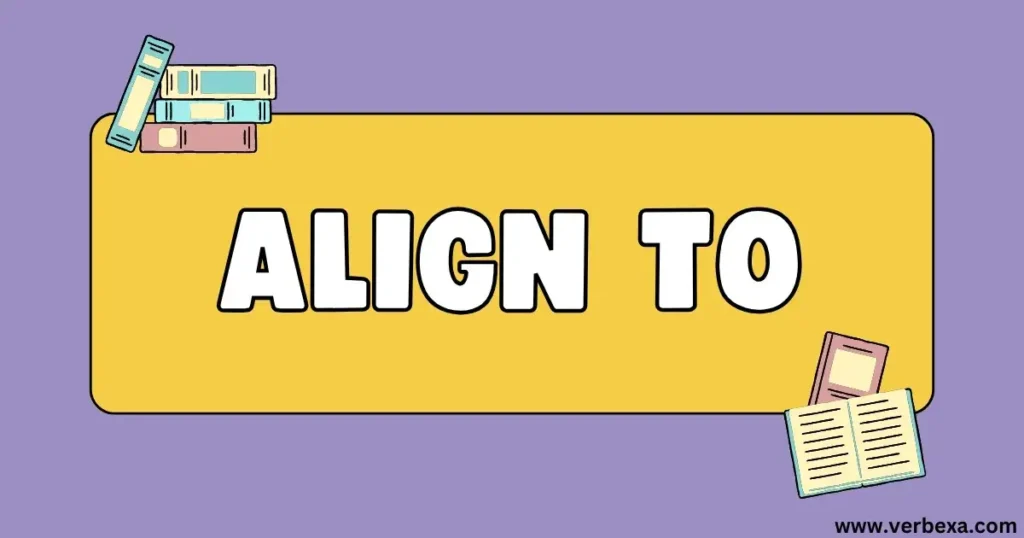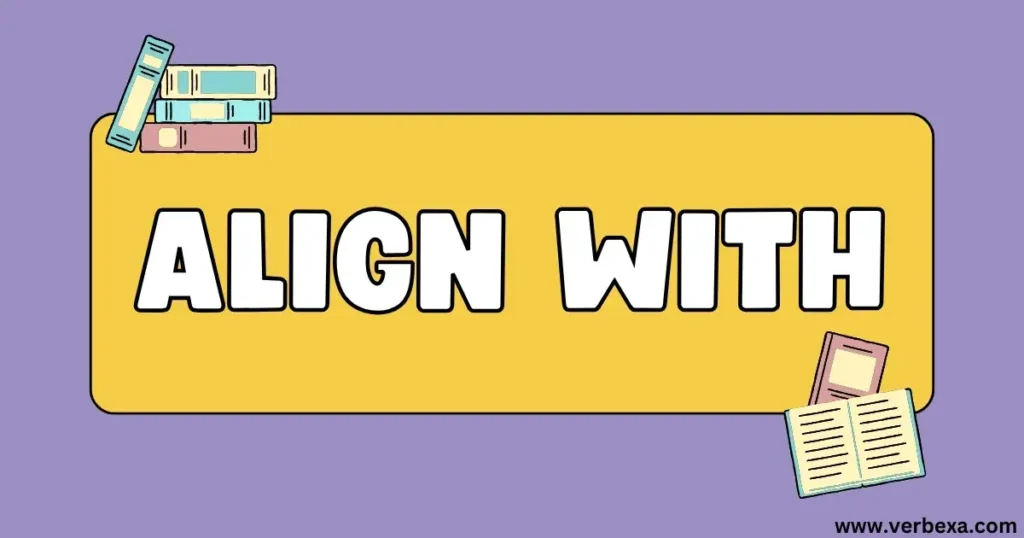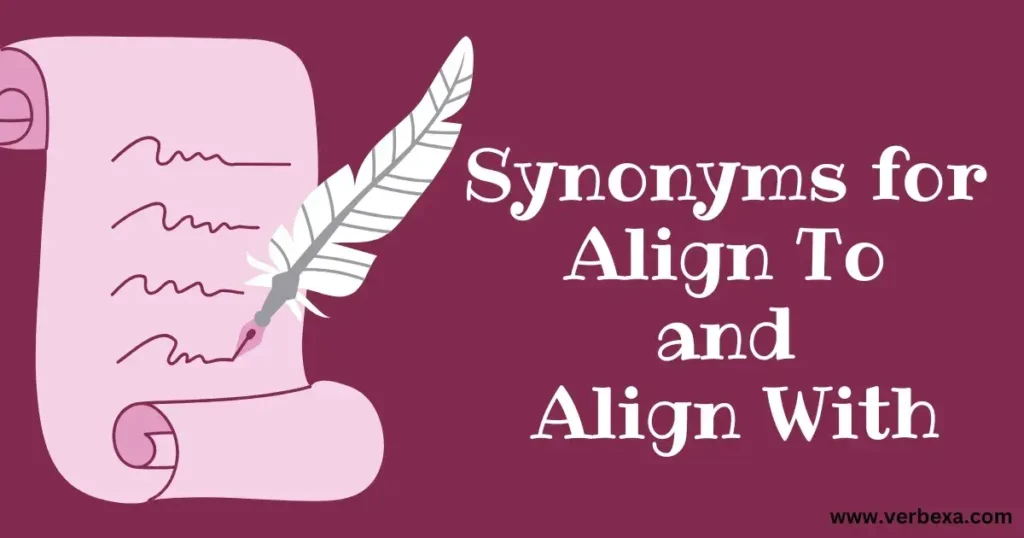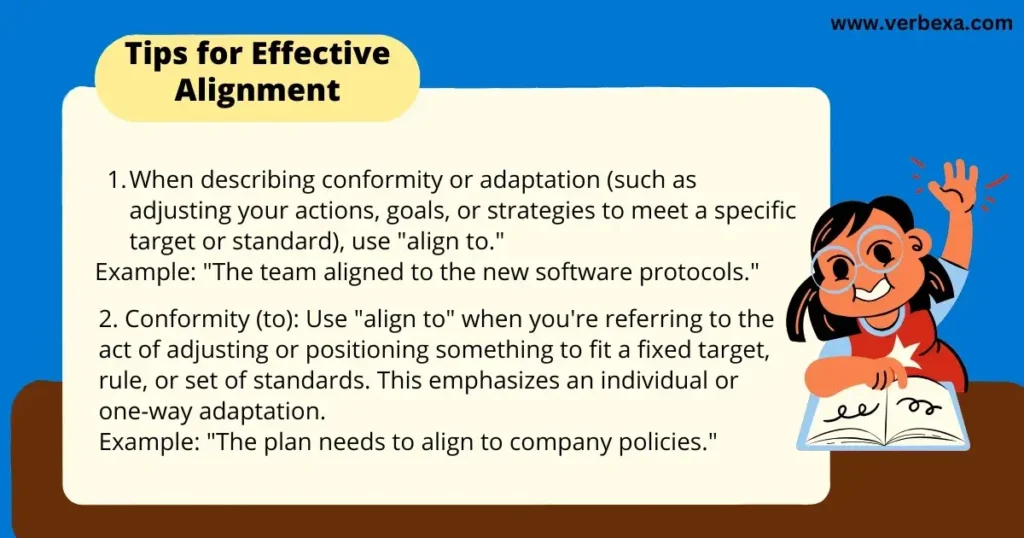Many often find themselves unsure whether to use align to or align with in certain contexts. These two phrases might seem similar at first glance, but they have distinct meanings and applications. Understanding when and how to use align to or align with correctly can significantly improve your communication skills, especially in professional or academic settings.
In this article, we’ll delve deep into the differences between these terms, their proper usage, and how you can use them effectively to convey your message clearly.
Align To vs Align With: What’s the Difference?
When discussing alignment, there are two primary ways to phrase it: align to and align with. These phrases might look similar, but they function differently depending on the context and the type of relationship being described.
Understanding when to use align with or to, or whether to say aligned to or aligned with, can help clarify the intended meaning. The key difference lies in whether the action is about conforming to something specific (using aligned to or with) or cooperating with others towards a shared goal (using align with or align to).
- Align To: This phrase indicates precise adjustment or positioning in relation to a specific standard, guideline, or target. It often refers to conforming to or adhering to a specific rule, structure, or expectation. For example, when a project aligns to a certain industry standard, it means the project is adjusted to meet that standard.
- Align With: On the other hand, align with generally refers to harmony, agreement, or compatibility between two or more entities. It emphasizes mutual understanding, shared goals, or cooperation. When two people’s views align with each other, it means they are in agreement or on the same page.
Short Answer:
- Align to is used when you’re talking about precise adjustment or adherence to a standard or requirement.
- Align with is used when you’re talking about agreement or harmony with someone or something.
Definitions and Usage: Align To or Align With
Align To

The phrase “align to” generally refers to the action of adjusting or positioning something in accordance with a specific standard, guideline, or requirement. It emphasizes a precise adjustment to fit a predetermined structure or rule. When you say something aligns to a particular standard, you are suggesting that it conforms to that standard’s expectations or parameters.
In essence, align to is about conformity, precision, or adherence to an established rule or benchmark. This makes it particularly useful in technical, professional, or academic contexts where exactness is important.
Proper Usage: When “Align To” Makes Sense
Use “align to” when the focus is on adjusting or conforming to a particular guideline, rule, or structure. The term is typically used when you want to express that something needs to fit within a predefined system or set of requirements.
It’s most often seen in contexts where there is a clear framework or standard to be followed. This could involve business operations, technical setups, or even personal goals that need to be adjusted to fit an overarching strategy or structure.
Examples of “Align To” in Action
- Business Context:
“The company aligns to industry standards.”- In this case, the company is adjusting its practices, products, or services to meet recognized standards within its industry. It indicates that their methods are in strict conformity with the rules or benchmarks established by the industry.
- Personal Goals Context:
“She aligned her goals to the team’s vision.”- Here, the individual adjusted her personal goals to fit with the larger vision of the team or organization. This shows that her goals are not random but are carefully designed to fit a broader strategic direction.
- Project Management Context:
“The project plan needs to align to the budget constraints.”- This example shows that the project plan has to be adjusted to fit within the limitations of the available budget. It emphasizes the need for the project to conform to the financial guidelines.
Common Contexts for “Align To”
- Business and Corporate Settings: Often used to describe a company’s strategies, actions, or policies that need to conform to industry standards, regulatory requirements, or strategic goals.
- Project Management: When planning or executing projects, you may need to align to timelines, budgets, or predetermined frameworks.
- Personal and Career Goals: Individuals may need to align their goals to the broader vision of their team or organization.
- Technical Fields: In engineering, programming, or other technical areas, things must often align to specific design standards or technical specifications.
Align With

The phrase “align with” refers to the idea of achieving harmony, agreement, or compatibility between two or more entities. When you say something aligns with another thing, you are highlighting that there is a mutual understanding, shared values, or common goals between the two. This phrase is less about precise adjustment and more about collaboration, coordination, or cooperation.
At its core, align with emphasizes compatibility—whether it’s a person, an idea, or an organization—highlighting a common purpose or agreement. It suggests that both (or all) entities are on the same page or moving in the same direction.
Proper Usage: When “Align With” is Preferred
Use “align with” when you want to express that two or more entities are in agreement, harmony, or compatibility with each other. This term is particularly fitting in situations involving shared goals, values, or ideas. Whether you’re talking about people, teams, organizations, or concepts, align with is used to convey the idea of unity or agreement.
Unlike align to, which emphasizes precise adjustment to an external standard or requirement, align with is about forming a collective understanding or working toward a common objective. It often applies in both social and professional settings.
Examples of “Align With” in Action
- Corporate or Organizational Context: “The new project aligns with our core values.”
- In this example, the project is not simply adjusting to a technical or regulatory standard (as with align to), but rather, it resonates with the core values of the company. The project is in harmony with what the organization stands for and aims to achieve.
- Interpersonal or Team Context:
“Their ideas aligned with mine from the start.”- Here, the speaker is talking about how their ideas and those of another person were in agreement from the beginning. This reflects mutual understanding and shared vision, making it a perfect fit for align with.
- Social Context: “Her actions align with her beliefs about social justice.”
- This example emphasizes the harmony between someone’s personal beliefs and the actions they take, suggesting that there is no contradiction between the two.
Common Contexts for “Align With”
- Social and Interpersonal Settings: When two individuals or groups have similar values, ideas, or goals, you would say their opinions align with each other. It’s about shared understanding or agreement.
- Professional and Organizational Settings: In businesses or teams, aligning with the company’s mission, vision, or strategic direction is important. It signifies compatibility in purpose or shared goals.
- Ideational Contexts: When discussing concepts, philosophies, or ideologies, aligning with refers to an agreement or agreement with a particular viewpoint. For example, you might say that a policy aligns with ethical principles, meaning it follows those guiding moral standards.
- Teamwork and Collaboration: When team members work together toward a common objective or goal, their efforts need to align with each other to achieve success.
In essence, align with is ideal for contexts where agreement, harmony, or shared direction is at play. Whether it’s about personal values, team objectives, or company goals, this term helps communicate that all parties are in sync or working together toward a common aim.
30 Examples of “Align With”
Here are 30 practical examples of how to use “align with” in various contexts, from business to personal interactions. These sentences will help you understand how to apply “align with” appropriately in a variety of situations.
Business & Professional Contexts:
- “The marketing strategy aligns with the company’s long-term goals.”
- “Our product development approach must align with consumer needs.”
- “The team’s objectives should align with the company’s mission.”
- “Her actions always align with the organization’s ethical guidelines.”
- “The new software system aligns with industry best practices.”
- “The budget proposal aligns with our fiscal year’s objectives.”
- “We need to ensure that our strategic initiatives align with market trends.”
- “The company’s values align with sustainable business practices.”
- “This partnership aligns with our growth strategy in Asia.”
- “The team’s vision aligns with the CEO’s leadership philosophy.”
Social & Interpersonal Contexts:
- “Their opinions align with mine on climate change action.”
- “We found that our values align with each other, which made working together easy.”
- “Her personality aligns with the company culture, making her a great fit.”
- “The teacher’s teaching methods align with modern educational philosophies.”
- “His actions never align with his words, which makes him hard to trust.”
- “Our goals align with those of the community, so we’re collaborating on this project.”
- “The two friends’ perspectives on personal growth align with each other perfectly.”
- “Their vision for the future aligns with the mission of the nonprofit.”
- “Her work ethic aligns with our team’s values of dedication and collaboration.”
- “We try to align with customers’ expectations to enhance satisfaction.”
Personal Goals & Self-Improvement:
- “Her personal beliefs align with the changes she is making in her lifestyle.”
- “To succeed, your daily actions should align with your long-term goals.”
- “His approach to life aligns with his deep passion for environmental conservation.”
- “My values align with my desire to help others, which is why I work in social services.”
- “This decision doesn’t align with my personal vision for the future.”
- “I try to ensure that my career goals align with my personal values.”
- “The choices I make in my health journey align with my wellness aspirations.”
- “Her career path aligns with her passion for education and mentorship.”
- “The steps I take every day align with my commitment to a balanced life.”
- “If your actions don’t align with your aspirations, it will be difficult to achieve them.”
Key Differences: Align To vs Align With

Syntax and Structure: How Each Phrase Fits Grammatically
- “Align to”: This is used when something adjusts or conforms to a specific standard or requirement. It suggests a one-way adjustment.
- Example: “The design aligns to the new guidelines.”
- “Align with”: This indicates a mutual agreement or compatibility between two things. It highlights shared goals or values.
- Example: “Their goals align with ours.”
Prepositional Differences: Why “To” and “With” Affect Meaning
- “To”: Implies precise adjustment to a standard or specific guideline.
- “With”: Implies compatibility or agreement between two or more entities.
Implication of Alignment: Subtle Shifts in Meaning
- “Align to” focuses on conforming or adjusting something to a defined rule.
- “Align with” emphasizes shared goals or agreement between two things.
In short, align to is about adjustment to a standard, while align with refers to being in harmony or agreement with something else.
Synonyms for Align To and Align With

Synonyms for Align To:
- Conform to
- Adapt to
- Comply with
- Match to
- Adjust to
- Fit to
- Correspond to
- Accord with
- Align itself with
- Fit in with
Align With Synonyms:
- Agree with
- Match with
- Coordinate with
- Concur with
- Harmonize with
- Be in tune with
- Correspond with
- Be in line with
- Be compatible with
- Synchronize with
Comparison Table: Align To vs. Align With
| Aspect | Align To | Align With |
|---|---|---|
| Meaning | Adjustment or positioning to a specific standard | Agreement, compatibility, or harmony between entities |
| Usage Context | Used when conforming to or matching specific guidelines | Used when expressing mutual understanding or shared goals |
| Common Fields | Business, engineering, technical, planning | Personal relationships, teamwork, organizational goals |
| Preposition | Aligns to a standard, guideline, or requirement | Aligns with a person, group, or idea |
| Tone | More formal, precise, and technical | More collaborative, social, and cooperative |
30 Key Differences: Align To vs Align With
1. Subject Focus
- Example: “The startup aligns its products to customer preferences.”
- Example: “The team aligned its goals with the company’s mission.”
2. Action Type
- Example: “She aligned her schedule to meet the deadline.”
- Example: “The manager aligned the department’s objectives with company values.”
3. Goal Orientation
- Example: “He aligned his diet to his fitness goals.”
- Example: “The project aligned with the client’s expectations.”
4. Adaptability
- Example: “The company aligned its strategies to market trends.”
- Example: “The team aligned with the shared objectives of the project.”
5. Personal vs. Collective Context
- Example: “The leaders aligned with the employees to create a unified vision.”
- Example: “The student aligned his research to academic guidelines.”
6. Conformity vs. Compatibility
- Example: “The organization aligned its policies to government regulations.”
- Example: “The new software aligns with industry standards.”
7. Use in Business Strategy
- Example: “The firm aligned its operations to financial goals.”
- Example: “The company aligned its values with its clients’ needs.”
8. Importance in Leadership
- Example: “The CEO aligned her decisions to the company’s long-term strategy.”
- Example: “The manager aligned her team’s objectives with the company’s vision.”
9. Legal and Regulatory Contexts
- Example: “The company aligned its operations to compliance standards.”
- Example: “The business aligned with international sustainability guidelines.”
10. Use in Marketing
- Example: “The brand aligned its product design to consumer preferences.”
- Example: “The campaign aligned with the environmental goals of the company.”
11. Conformity vs. Collaboration
- Example: “Her performance was aligned to the set KPIs.”
- Example: “The project team aligned with the client’s requirements.”
12. Use in Education
- Example: “The course syllabus was aligned to the national curriculum.”
- Example: “The teacher aligned her teaching methods with students’ learning styles.”
13. Goal Flexibility
- Example: “His career path aligned to his personal ambitions.”
- Example: “Her vision aligned with the company’s evolving goals.”
14. Strategy in Project Management
- Example: “The project manager aligned the deadlines to client expectations.”
- Example: “The team aligned their resources with the overall project strategy.”
15. Communication and Coordination
- Example: “The marketing department aligned its messaging to the brand strategy.”
- Example: “The leadership aligned their message with the organization’s core principles.”
16. Use in Technology
- Example: “The software was aligned to the latest security protocols.”
- Example: “The system was aligned with customer feedback.”
17. Focus on Process vs. People
- Example: “The company aligned its production processes to global quality standards.”
- Example: “The team aligned with the customer’s priorities.”
18. Precision vs. Agreement
- Example: “His skills aligned to the technical requirements.”
- Example: “Her work aligns with the department’s core values.”
19. In Business Partnerships
- Example: “The company aligned its offerings to customer needs.”
- Example: “The company aligned with its strategic partners for growth.”
20. Focus on Standards
- Example: “The company aligned its operations to the ISO certification.”
- Example: “The team aligned with global industry standards.”
21. Adaptability in Personal Development
- Align To: Personal goals ko defined frameworks ke hisaab se adjust karna.
- Example: “She aligned her career goals to industry expectations.”
- Align With: Personal development ko collective values ya goals ke saath harmonize karna.
- Example: “His values aligned with the company’s vision.”
22. Use in Law and Regulations
- Example: “The firm aligned its practices to regulatory requirements.”
- Example: “The company aligned with environmental protection laws.”
23. Cultural Context
- Example: “Her communication style aligned to company policies.”
- Example: “The organization aligned with global diversity standards.”
24. Focus on Operations
- Example: “The business aligned its operational model to market trends.”
- Example: “The production team aligned with overall business goals.”
25. Time Management
- Example: “The project manager aligned the schedule to the client’s needs.”
- Example: “The deadlines were aligned with the project goals.”
26. Team Objectives
- Example: “The employee aligned his personal objectives to the department’s strategy.”
- Example: “The team aligned with the company’s mission.”
27. Focus on Results
- Example: “The company aligned its marketing efforts to sales targets.”
- Example: “The team aligned with the organization’s mission to improve customer service.”
28. Strategic Planning
- Example: “The CEO aligned his vision to the company’s growth strategy.”
- Example: “The manager aligned the department’s goals with the company’s vision.”
29. Conflict Resolution
- Example: “They aligned their objectives to resolve the disagreement.”
- Example: “The team aligned with the client’s expectations to settle the dispute.”
30. Planning for Change
- Example: “The business aligned its strategy to the changing market demands.”
- Example: “The organization aligned with the new regulatory standards.”
Examples of Aligning To: Proper Usage and Context
Business & Corporate:
- Example 1: “Our goals need to align to the budget constraints.”
- Why it works: Here, “align to” emphasizes the adjustment of personal or team goals to meet the specific financial standard or limit set by the budget.
- Example 2: “The project aligns to the deadlines set by the manager.”
- Why it works: “Align to” in this context shows that the project’s schedule is being adjusted to a fixed target — the manager’s deadlines.
Other Fields:
- Example 3: “The research methods align to the approved guidelines.”
- Why it works: “Align to” indicates that the research methods conform to a predefined set of guidelines.
- Example 4: “Her diet plan aligns to her fitness goals.”
- Why it works: This use of “align to” suggests that the individual is adapting her diet to meet specific personal objectives related to fitness.
Examples of Aligning With: Proper Usage and Context

Social & Professional Alignment:
- Example 1: “Her vision aligns with our mission statement.”
- Why it works: “Align with” demonstrates a harmony of ideas or values between the individual and the organization.
- Example 2: “They aligned with the local community’s needs.”
- Why it works: Here, “align with” emphasizes that actions are in agreement or consistent with the needs of the community, indicating a shared understanding or common goal.
By using “align to” and “align with” correctly, you can clearly express either a one-way adjustment to a set target or a mutual agreement with others.
When to Use Each Term
Knowing when to use align to or align with often depends on whether you’re emphasizing precision and conformity or agreement and collaboration. Here are a few actionable tips to guide you:
- Use “Align To”:
- When referring to conformity with a specific guideline or standard.
- In contexts requiring precision and adjustment to specific criteria (such as aligning to rules, plans, or strategies).
- Use “Align With”:
- When talking about agreement, harmony, or mutual understanding.In contexts where collaboration or shared goals are being emphasized.
Tips for Effective Alignment: Choosing Between Align To and Align With

Choosing between “align to” and “align with” depends on the context and the action you’re describing. Here’s how to make the right choice:
Practical Tips: How to Pick the Right Phrase Based on Context
- When describing conformity or adaptation (such as adjusting your actions, goals, or strategies to meet a specific target or standard), use “align to.”
- Example: “The team aligned to the new software protocols.”
- When discussing agreement, cooperation, or harmony between people, groups, or ideas, use “align with.”
- Example: “Her beliefs align with the organization’s core values.”
Mental Checkpoints: Does the Phrase Describe Conformity (to) or Agreement (with)?
- Conformity (to): Use “align to” when you’re referring to the act of adjusting or positioning something to fit a fixed target, rule, or set of standards. This emphasizes an individual or one-way adaptation.
- Example: “The plan needs to align to company policies.”
- Agreement (with): Use “align with” when you’re focusing on cooperation, harmony, or mutual agreement between entities.
- Example: “Our strategies align with the client’s expectations.”
When to Be Flexible: Understanding That Context Can Influence Choice
Sometimes, context can influence whether you should use “align to” or “align with.” For example:
- Personal vs. collective goals: If you’re adjusting personal behavior to fit a goal, “align to” works. If you’re discussing how a team or group works together toward a shared goal, “align with” is more appropriate.
- Personal goal example: “He aligned his career path to his long-term aspirations.”
- Team goal example: “The team aligned with the company’s mission.”
Ask Yourself: Are You Aligning to Something Specific (Direction, Standards) or With Someone/Something (Values, Ideas)?
- Align to: Use this when focusing on specific standards, guidelines, or measurable goals that require direct conformity.
- Example: “The policy aligns to the new regulatory requirements.”
- Align with: Use this when focusing on shared values, collective ideas, or mutual agreements.
- Example: “The organization’s vision aligns with the values of its employees.”
Common Mistakes to Avoid: Align To or Align With?
Many people misuse align to and align with by not understanding their distinct meanings. Here are a few mistakes to avoid:
Mistakes:
- Incorrect: “The team must align to their core values.”
- Correction: “The team must align with their core values.”
- Incorrect: “Our project is aligned with the budget guidelines.”
- Correction: “Our project is aligned to the budget guidelines.”
In these examples, the wrong preposition is used, which leads to confusion about whether the focus is on conformity (to) or compatibility (with).
FAQs
Is it to align with or align on?
“Align with” is used when referring to agreement or harmony with something, while “align on” typically relates to reaching a shared decision or position.
What does “aligned to” or “with” mean?
“Aligned to” suggests conformity to a specific target, while “aligned with” indicates a mutual agreement or compatibility between two things.
What preposition is used with align?
The prepositions “to” and “with” are commonly used with “align,” depending on whether you are adjusting to a standard or harmonizing with a group.
What does it mean to align with something?
To align with something means to adjust or harmonize one’s actions, values, or ideas to match or support it.
What does it mean to align with work?
To align with work means ensuring your goals, values, or efforts are in sync with the objectives and expectations of your job or team.
Conclusion
Understanding when to use align to and align with is crucial for clear, effective communication. The key differences between the two can significantly impact the clarity of your writing and speaking:
- Align to is used when you need to emphasize conformity, precision, or adherence to a specific standard, rule, or guideline.
- Align with is used to describe agreement, harmony, or compatibility between people, ideas, or objectives.
By following these distinctions, you’ll be able to choose the right phrase in both professional and personal settings, ensuring your communication is clear, accurate, and effective.
Final Tips:
- Think about whether you are aligning with someone or something (harmony, mutual agreement) or aligning to something (conformity, standards).
- Use align to for technical, formal contexts, and align with for interpersonal or collective alignment.
Mastering the use of align to or align with will not only improve your grammar but also ensure that you’re always expressing yourself with precision and clarity.

This author is a passionate linguist and grammar enthusiast, dedicated to helping individuals master the art of language. With years of experience in teaching and editing, she brings clarity and precision to every sentence. Tina’s mission is to empower writers of all levels to express themselves with confidence and excellence.

![Align To or Align With: Which is Correct? [+ Examples]](https://verbexa.com/wp-content/uploads/2025/01/align-to-or-align-with-which-is-correct-examples.webp)